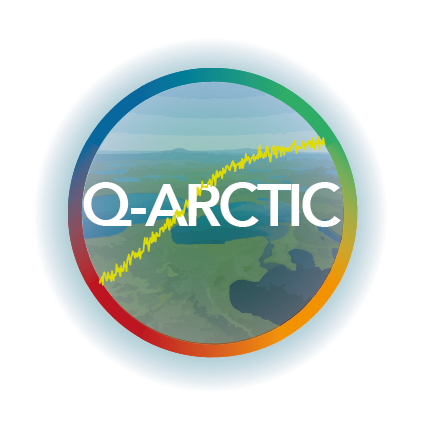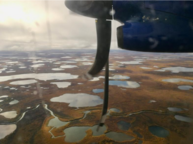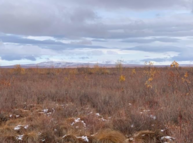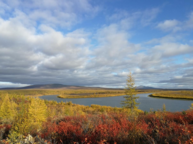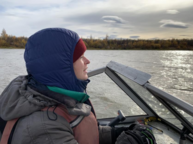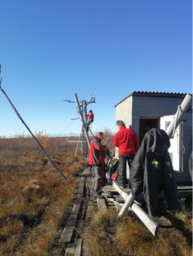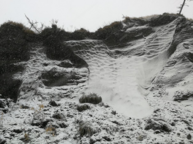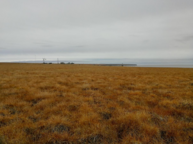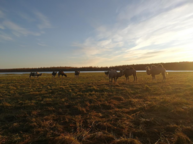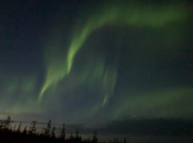Cherskii Field Trip
Meike Schickhoff, PhD student at MPI for Meteorology, shares her impressions about field trip to Chersky
For months it seemed literally impossible, but nevertheless, and despite all Covid-related restrictions, we finally made our way to Cherskii, Eastern Siberia, in September 2021. We – that is Mathias Goeckede, Q-Arctic principal investigator, Olaf Kolle and Martin Hertel, experts in technical aspects of outdoor measurements, and me, a PhD student working on permafrost modelling.
After spending some unwanted extra time in Yakutsk airport, we arrived with a day of delay to our destination. Already the flight into Cherskii was stunning! We were lucky and got an amazing view of the Kolyma lowlands, a stretch of wetlands to the west of Cherskii. This region is very prone to thermokarst, clearly recognizable by the vast number of partly huge lakes.
Later in the research station, we were warmly welcomed by Sergey Zimov and his family, with a delicious lunch and, according to Russian traditions, a decent bottle of Vodka. Afterwards, we had a walk around the research station and I got my first close-up impressions of the beautiful landscape. It is classified as tundra-taiga ecotone, the transition zone between boreal forests and the open, treeless landscapes further north. Forests here are dominated by larch trees, which are well adapted to the permafrost conditions. Since these trees are deciduous, unlike most other conifers, they prevent drought stress during early spring, when enough sunlight promotes photosynthesis but soil water is still mostly frozen and unavailable.
The floodplains are tundra landscapes and dominated by tussocks, a growth strategy where grass species develop small hummocks to escape from standing water. In between, there are bigger shrubs like willows and birch and – at my great pleasure – smaller ones like blueberry shrubs that hold loads of berries in early September.
A network of small rivers and side-channels of the Kolyma river divides the landscape. Some of the watercourses are used for transportation – by boat in summer and by car on frozen channels during winter. During daytrips to the measurement site, I luckily got the chance to make some motor boat driving experiences and while I got some critical remarks about too speedy accelerations, I still feel like a semi-professional boat driver now...
The measurement site is located in a floodplain which is flooded usually once per year in spring. There are two eddy covariance towers on site, one of them in the middle of a circular drainage ditch, the other outside of it in natural hydrological conditions. This setup gives insights into differences between drier and wetter Arctic landscapes.
At the site, Olaf and Martin kept busy maintaining all the instruments of the eddy covariance towers. Mathias and I examined all the groundwater level loggers and especially their height from the surface. The distance between the loggers and the groundwater level has increased in recent years - either due to the groundwater level lowering by drying of the landscape in the past couple of years or due to the loggers, which are fastened to the soil, being pushed up by frost heaving. Funnily enough, a Russian film crew, who stayed in the research station with us, took some shots of us maintaining the level loggers. Whether we like it or not - Mathias and I will be appearing somewhere in Russian TV in the near future.
Apart from staying at the measurement site, we also got the chance to do some further explorations of the area around Cherskii. Mathias was eager to find potential future sampling spots with signs of landscape disturbances (e.g. fire or thermokarst) for his measurement campaign next summer and I conducted ground truthing of satellite data and therefor pushed my way through the bushes.
One day, I joined the Russian film crew in an excursion to Duvanny Yar – an site featuring eroding permafrost riverbanks at an outer bend of the Kolyma river. The eroded steep slope reveals the huge ice wedges in the Yedoma soil. The ice wedges usually have a dark and shiny appearance, but due to the weather conditions of snowfall at 1° C, on the day of our trip the ice wedges could be identified rather by their very white color. Snow covering the ice wedges remained there due to the low temperature of the ice, while it melted in the warmer parts surrounding the ice wedges. I started chatting with Joshua Yaffa, a journalist accompanying us that day, and the story goes that a soil sample of old, frozen Yedoma soil of Duvanny Yar was brought for further investigation to some research laboratory. The scientists melted the soil sample and suddenly, a previously frozen worm from 32.000 years ago woke up and rose from the (seemingly) dead.
Some days later, we took a 4.5-hour boat drive northwards to Ambarchik at the Arctic ocean coast to maintain the local atmospheric monitoring tower. Ambarchik is a small settlement in the tundra which currently hosts only three meteorologists operating the local weather station. The station was built in Soviet times to support Russian explorations of the Arctic Ocean. Even earlier than that, during the 1930s, the place was used as a Gulag - a Soviet forced labor camp.
The tundra fascinated me. There were no trees and no shrubs anywhere around and even the tussocks were quite a bit smaller than the ones from the floodplains that I was used to. Here, the tussocks use their piling strategy mainly in order to save nutrients, since water is less of a problem here than in the floodplains. But above all, the remoteness of the place struck me. The people living here are dependent on Cherskii inhabitants passing by to get access to fresh food. Also, the internet connection exists only since THREE years ago!
Last, but not least, we took a boat drive to the materialization of the Zimovs’ seemingly crazy, but famous idea - the Pleistocene park. The idea itself is simple: Dense animal populations can sustain the permafrost by scratching away snow while looking for forage in winter times. Without the insulation of a thick snow layer, the cold air can then directly reach the soil and the frost can infiltrate a lot deeper. This sustains the cold soil temperatures.
The Zimovs envision the park to look like the Arctic during Pleistocene times - big animal herds populate vast Arctic grasslands. Therefore, the Zimovs are buying big herbivores like moose, bison, horses, goats and camels for the park (I never imagined that camels could endure hard Arctic winters...). During our stay at the research station, a bunch of young bison shipped from Denmark arrived at the park. While unloading them, one bison fled to the tundra and so far, was not to be seen again.
In retrospective, I learned a lot about the Arctic and its permafrost and landscape processes during my stay in Cherskii – quite a lot more than in the times before that I spent sitting at my desk in Hamburg reading papers. Furthermore, we did not do science 24/7. One evening for instance, we were super lucky and got to watch some beautiful northern lights appearing and moving in the clear nighttime sky. Another night Leonid, a local fisherman and close friend of the Zimov family, came to visit us at the research station and performed a little concert with his skillful guitar play and his beautiful voice. A lot of memories associated with good Siberian times that will stay on my mind ...
Thanks to Olaf and Maxim for some of the pictures!
